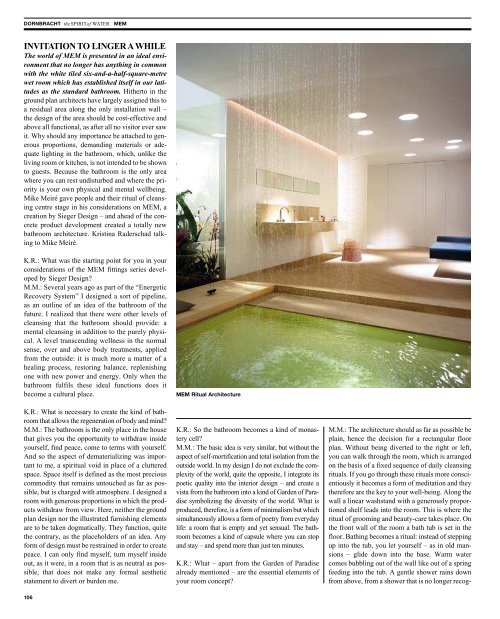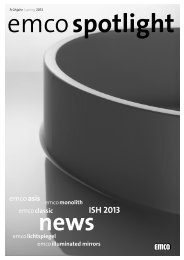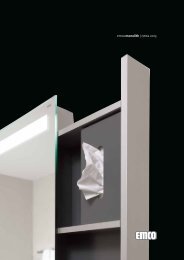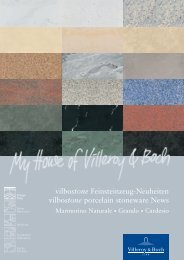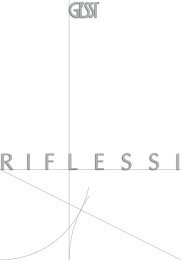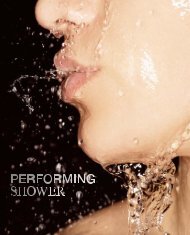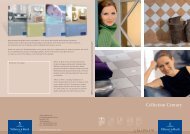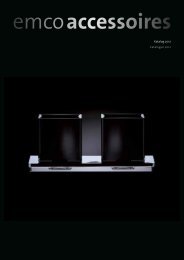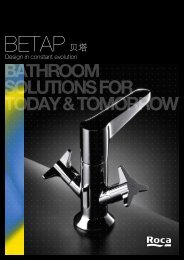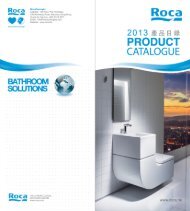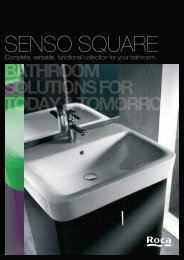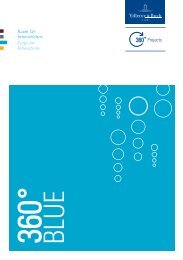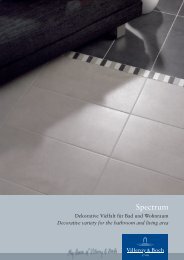productos Dornbracht - The BSC Group of Company
productos Dornbracht - The BSC Group of Company
productos Dornbracht - The BSC Group of Company
You also want an ePaper? Increase the reach of your titles
YUMPU automatically turns print PDFs into web optimized ePapers that Google loves.
DORNBRACHT the SPIRIT<strong>of</strong> WATER MEM<br />
INVITATION TO LINGER A WHILE<br />
<strong>The</strong> world <strong>of</strong> MEM is presented in an ideal environment<br />
that no longer has anything in common<br />
with the white tiled six-and-a-half-square-metre<br />
wet room which has established itself in our latitudes<br />
as the standard bathroom. Hitherto in the<br />
ground plan architects have largely assigned this to<br />
a residual area along the only installation wall –<br />
the design <strong>of</strong> the area should be cost-effective and<br />
above all functional, as after all no visitor ever saw<br />
it. Why should any importance be attached to generous<br />
proportions, demanding materials or adequate<br />
lighting in the bathroom, which, unlike the<br />
living room or kitchen, is not intended to be shown<br />
to guests. Because the bathroom is the only area<br />
where you can rest undisturbed and where the priority<br />
is your own physical and mental wellbeing.<br />
Mike Meiré gave people and their ritual <strong>of</strong> cleansing<br />
centre stage in his considerations on MEM, a<br />
creation by Sieger Design – and ahead <strong>of</strong> the concrete<br />
product development created a totally new<br />
bathroom architecture. Kristina Raderschad talking<br />
to Mike Meiré.<br />
K.R.: What was the starting point for you in your<br />
considerations <strong>of</strong> the MEM fittings series developed<br />
by Sieger Design?<br />
M.M.: Several years ago as part <strong>of</strong> the “Energetic<br />
Recovery System” I designed a sort <strong>of</strong> pipeline,<br />
as an outline <strong>of</strong> an idea <strong>of</strong> the bathroom <strong>of</strong> the<br />
future. I realized that there were other levels <strong>of</strong><br />
cleansing that the bathroom should provide: a<br />
mental cleansing in addition to the purely physical.<br />
A level transcending wellness in the normal<br />
sense, over and above body treatments, applied<br />
from the outside: it is much more a matter <strong>of</strong> a<br />
healing process, restoring balance, replenishing<br />
one with new power and energy. Only when the<br />
bathroom fulfils these ideal functions does it<br />
become a cultural place.<br />
K.R.: What is necessary to create the kind <strong>of</strong> bathroom<br />
that allows the regeneration <strong>of</strong> body and mind?<br />
M.M.: <strong>The</strong> bathroom is the only place in the house<br />
that gives you the opportunity to withdraw inside<br />
yourself, find peace, come to terms with yourself.<br />
And so the aspect <strong>of</strong> dematerializing was important<br />
to me, a spiritual void in place <strong>of</strong> a cluttered<br />
space. Space itself is defined as the most precious<br />
commodity that remains untouched as far as possible,<br />
but is charged with atmosphere. I designed a<br />
room with generous proportions in which the products<br />
withdraw from view. Here, neither the ground<br />
plan design nor the illustrated furnishing elements<br />
are to be taken dogmatically. <strong>The</strong>y function, quite<br />
the contrary, as the placeholders <strong>of</strong> an idea. Any<br />
form <strong>of</strong> design must be restrained in order to create<br />
peace. I can only find myself, turn myself inside<br />
out, as it were, in a room that is as neutral as possible,<br />
that does not make any formal aesthetic<br />
statement to divert or burden me.<br />
MEM Ritual Architecture<br />
K.R.: So the bathroom becomes a kind <strong>of</strong> monastery<br />
cell?<br />
M.M.: <strong>The</strong> basic idea is very similar, but without the<br />
aspect <strong>of</strong> self-mortification and total isolation from the<br />
outside world. In my design I do not exclude the complexity<br />
<strong>of</strong> the world, quite the opposite, I integrate its<br />
poetic quality into the interior design – and create a<br />
vista from the bathroom into a kind <strong>of</strong> Garden <strong>of</strong> Paradise<br />
symbolizing the diversity <strong>of</strong> the world. What is<br />
produced, therefore, is a form <strong>of</strong> minimalism but which<br />
simultaneously allows a form <strong>of</strong> poetry from everyday<br />
life: a room that is empty and yet sensual. <strong>The</strong> bathroom<br />
becomes a kind <strong>of</strong> capsule where you can stop<br />
and stay – and spend more than just ten minutes.<br />
K.R.: What – apart from the Garden <strong>of</strong> Paradise<br />
already mentioned – are the essential elements <strong>of</strong><br />
your room concept?<br />
M.M.: <strong>The</strong> architecture should as far as possible be<br />
plain, hence the decision for a rectangular floor<br />
plan. Without being diverted to the right or left,<br />
you can walk through the room, which is arranged<br />
on the basis <strong>of</strong> a fixed sequence <strong>of</strong> daily cleansing<br />
rituals. If you go through these rituals more conscientiously<br />
it becomes a form <strong>of</strong> meditation and they<br />
therefore are the key to your well-being. Along the<br />
wall a linear washstand with a generously proportioned<br />
shelf leads into the room. This is where the<br />
ritual <strong>of</strong> grooming and beauty-care takes place. On<br />
the front wall <strong>of</strong> the room a bath tub is set in the<br />
floor. Bathing becomes a ritual: instead <strong>of</strong> stepping<br />
up into the tub, you let yourself – as in old mansions<br />
– glide down into the base. Warm water<br />
comes bubbling out <strong>of</strong> the wall like out <strong>of</strong> a spring<br />
feeding into the tub. A gentle shower rains down<br />
from above, from a shower that is no longer recog-<br />
nisable as such. Reduced to a rectangular plate<br />
integrated into the ceiling, the product is only defined<br />
as an interface in the architecture. From the<br />
tub, the view leads into an atrium with the aforementioned<br />
Garden <strong>of</strong> Paradise. After bathing you<br />
sit on the wooden bench next to the basin. <strong>The</strong><br />
awaiting cushion and the incense stick invite you<br />
to a ritual <strong>of</strong> relaxation: you light one <strong>of</strong> the incense<br />
sticks, direct your attention to the few important<br />
architectural details, take the time to observe,<br />
reflect and relax. Here what matters is not<br />
the actual cushion or incense stick, but the question:<br />
can you create a room which allows ideal<br />
functions, such as pausing and reflecting – can you<br />
create a room which invites raising consciousness?<br />
K.R.: In this context what role does the light play<br />
that shines down through what appears to be randomly<br />
arranged circular holes in the ceiling?<br />
M.M.: <strong>The</strong> circular “light holes” in the ceiling<br />
point in the same direction: if you sit down on the<br />
daybed – which also seems to float, to accentuate<br />
the lightness you feel after bathing, the relief<br />
from everyday life, a kind <strong>of</strong> floating feeling –<br />
they express an invitation to reflect and meditate.<br />
Anyone who has ever lain on the hot marble table<br />
in the middle <strong>of</strong> an oriental hammam, looking at<br />
the ceiling that is perforated with innumerable,<br />
sometimes coloured, glass light apertures is familiar<br />
with the unbelievably calming, almost<br />
hypnotic effect. In general, light is <strong>of</strong> crucial importance<br />
in a room where we want to feel good<br />
even when naked, which we enter first thing in<br />
the morning and last thing at night. Different<br />
lighting scenarios respond to the various moods<br />
in the morning and evening – sometimes light is<br />
stimulating, sometimes relaxing.<br />
INVITO ALL’INDUGIO<br />
Il mondo di MEM è presentato in un ambiente<br />
ideale, completamente diverso dal locale da<br />
6,5 m 2 piastrellato di bianco, tipico dello standard<br />
occidentale. Finora gli architetti nei progetti generalmente<br />
gli dedicavano uno spazio ricavato lungo<br />
l’unica parete sfruttabile e lo allestivano all’insegna<br />
dell’economicità e soprattutto della funzionalità,<br />
perché tanto nessun ospite lo vedeva. Perché<br />
in bagno bisognerebbe porre l’accento sulla grandezza,<br />
su materiali pregiati o su una buona illuminazione,<br />
se esso, contrariamente al soggiorno o<br />
alla cucina, non svolge alcuna funzione rappresentativa?<br />
Perché il bagno è l’unica stanza dove ci si<br />
può occupare di se stessi, indisturbati e in tutta<br />
tranquillità, dove ci si può concentrare sul proprio<br />
benessere fisico e spirituale. Mike Meiré ha posto<br />
l’uomo e i rituali del bagno al centro delle sue riflessioni<br />
sul mondo MEM, creato da Sieger Design,<br />
e, prima di dedicarsi allo sviluppo concreto<br />
dei prodotti, ha ideato un’architettura assoluta-<br />
DORNBRACHT the SPIRIT<strong>of</strong> WATER MEM<br />
Meditation place Washstand in front <strong>of</strong> Garden <strong>of</strong> Eden<br />
mente innovativa per questo spazio. Intervista di<br />
Kristina Raderschad a Mike Meiré.<br />
K.R.: Qual è stato per lei il punto di partenza per<br />
le riflessioni sulla serie di rubinetterie MEM, create<br />
da Sieger Design?<br />
M.M.: Qualche anno fa, nell’ambito dell’ “Energetic<br />
Recovery System”, ho sviluppato una specie di<br />
canalizzazione che doveva schematizzare l’idea<br />
del bagno del futuro. Mi sono reso conto allora che<br />
esiste un’altra concezione di questo spazio, da cui<br />
non si può prescindere: alla pulizia del corpo si<br />
affianca la purificazione dello spirito. Gesti che<br />
vanno oltre il benessere inteso nel senso comune<br />
del termine, quindi si spingono oltre la cura del<br />
corpo: ben più di un processo di guarigione e di<br />
riequilibrio per riprendere forza e attingere nuova<br />
energia. Solo se svolge queste funzioni ideali, il<br />
bagno diventa un luogo culturale.<br />
K.R.: Come deve essere l’allestimento di un bagno<br />
che consente la rigenerazione del corpo e dello spirito?<br />
M.M.: Il bagno è l’unico luogo della casa che <strong>of</strong>fre<br />
la possibilità di ritirarsi in se stessi, di trovare pace e<br />
concentrazione. Tanto da suggerirmi l’idea della<br />
smaterializzazione, cioè di un vuoto spirituale che si<br />
sostituisce a un luogo stipato di oggetti. Lo spazio in<br />
quanto tale si definisce come bene prezioso, intoccabile<br />
per quanto possibile, ma carico di atmosfera. Ho<br />
concepito una zona di ampio respiro, in cui gli oggetti<br />
passano in secondo piano dal punto di vista<br />
ottico. Non conviene dunque procedere all’interpretazione<br />
dogmatica della strutturazione del progetto<br />
o degli elementi di arredo rappresentati. Essi svolgono,<br />
al contrario, la funzione di simboli di un’idea.<br />
Ogni forma di design deve annientarsi per dare libero<br />
sfogo alla tranquillità. Posso trovare me stesso,<br />
ovvero estrinsecare il mio intimo solo in uno spazio<br />
neutrale al massimo, senza espressioni estetiche formali<br />
che mi distraggano o mi reprimano.<br />
K.R.: Il bagno allora diventa una sorta di cella conventuale?<br />
M.M.: L’idea di fondo è molto simile, ma senza<br />
l’aspetto dell’autopunizione e del completo isolamento<br />
dal mondo esterno. Il mio progetto non<br />
esclude la complessità del mondo, ma al contrario<br />
integra le sue qualità poetiche nella concezione di<br />
spazio, per creare dal bagno una visuale su una<br />
sorta di giardino paradisiaco che simboleggia la<br />
molteplicità del mondo. Ne scaturisce una forma di<br />
minimalismo che però contempla al tempo stesso<br />
una sorta di poesia del quotidiano; una stanza, sì<br />
vuota, ma tuttavia sensuale. Il bagno diventa una<br />
specie di cella, in cui potersi fermare e sostare – e<br />
trascorrere ben più di dieci minuti.<br />
MEM RITUAL ARCHITECTURE<br />
A bath tub sunk into the<br />
sandstone floor with a small<br />
seating area “on the bank”,<br />
nature integrated into the<br />
bathroom as a Garden <strong>of</strong><br />
Eden for mind and soul, coloured<br />
light as an expression<br />
<strong>of</strong> natural moods and a<br />
couch which seems to float –<br />
and with its airiness invites<br />
you to dream.<br />
Vasca annegata nel pavimento<br />
in grès con una piccola<br />
seduta sul bordo, natura<br />
integrata nel bagno come<br />
giardino dell’Eden per l’anima<br />
e lo spirito, luce colorata che<br />
accompagna atmosfere naturali<br />
e una poltrona che sembra<br />
galleggiare, la cui leggerezza<br />
invita al sogno.<br />
Una bañera encajada en el<br />
suelo de gres con una<br />
pequeña área de asiento<br />
“a la orilla”, naturaleza integrada<br />
en el baño en forma<br />
de Jardín del Edén para el<br />
espíritu y el alma, luz de<br />
colores como si se estuviera<br />
aludiendo a los estados de<br />
humor naturales y una tumbona<br />
que parece flotar – y<br />
que con su ligereza invita<br />
a soñar.<br />
106 107


